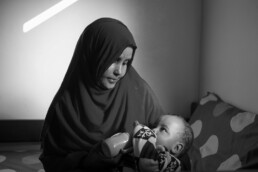Somaliland
In the northwestern part of Somalia lies the state of Somaliland. Somalia is often described as a failed state that until 2012 has run without an actual government. As the third last country in the world, Somalia ratified in January 2015 the UN Convention on the Rights of the Child.
While the rest of Somalia is plagued by conflict, Somaliland has implemented its own peace and democratization process, adopted a constitution and established its own state-like institutions.
Somaliland has the world’s fourth lowest GDP per capita, and there is a huge difference between rich and poor. Thus, there is a long way to go before it can achieve World Goal 1 on eradicating poverty.
Somaliland has very limited resources and is completely dependent on the support of organizations and Somalis living abroad. Although the government spends many of its limited resources on the security sector, it has invested in health, education, infrastructure, agriculture and job creation for young people.
Children in Somaliland
Only about half of the country’s children start in 1st grade because there is a lack of schools and trained teachers. In addition, 60 percent of the population still lives as nomads. Most schools have not been maintained for decades and teachers are uneducated and lack educational skills.
School leaders are rarely qualified to lead a school, and parents and students have very little influence on teaching. Far fewer girls go to school compared to boys. Therefore, there is also a long way to go to achieve World Goal 4 on quality education for all.
In general, children and young people have very little influence on their own lives, but it is the girls who have the most difficulty. Somalia is one of the worst places in the world to be a girl or a woman.
There is plenty of violence and abuse against girls and women who are expected to take care of the housework, while men have traditionally had control over the finances and all decisions that extend beyond the four walls of the home. Therefore, many families prioritize education for the boys.
Only five percent of all children are vaccinated. Therefore, diseases such as polio, diphtheria, tetanus, tuberculosis, measles and pertussis are the cause of every fifth death among children. The children who survive do not have an easy life in sight: two thirds of all young people are unemployed.
In Somaliland, SOS Children’s Villages works in Berbera, Hargeisa and Sheikh.

Facts about children
- Nearly half of the population is under 14 years of age.
- Nearly 11 percent of all children have lost one or both parents.
- Almost 21 procent of all children start in 1st grade.
- 26 percent of all children under the age of five do not develop as they should due to moderate or severe malnutrition.
- 80 percent of children are not treated for dehydration if they have diarrhea. 69 percent do not go to the doctor even if the child has symptoms of pneumonia.
Country facts
- Somaliland is formally part of Somalia.
- More than 3.5 million people live there.
- A Somali earns an average of 300 euro a year or 0,80 euro a day.
- 0.78 percent of adults live with HIV or AIDS.
- For every 100,000 children born, 1,440 women die from complications during pregnancy or childbirth.
- 29 percent of the urban population lives below the $ 1.90 poverty line per day.
Village communities in Somaliland
Support MY FOUNDATION's work in Somaliland, or become a partner in a project or a village community in the country.